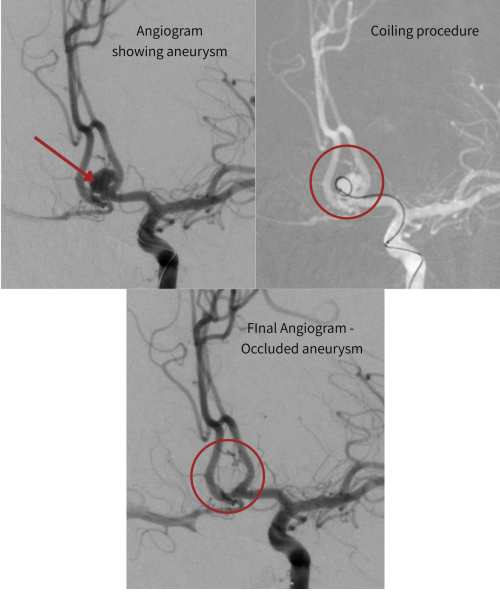About the VIEW Series :
Vascular Interventions. Every Week.
This series brings you real stories and insights into the world of Interventional Radiology—where advanced imaging meets precise, minimally invasive treatment. One condition at a time, one life-changing procedure a week

Mrs. A, a 42-year-old schoolteacher, had always been healthy. She rarely missed a day at work and led a quiet, disciplined life.
One afternoon, while correcting exam papers, she developed a sudden, intense headache.
“It felt like something burst inside my head. I have never had a headache like this,” she said later.
She felt dizzy and began vomiting. Her family brought her to the emergency department immediately.
A CT scan confirmed a subarachnoid hemorrhage — bleeding in the brain caused by a ruptured aneurysm. A follow-up angiogram showed a small saccular aneurysm in the anterior communicating artery, one of the more common sites.
Her neurologist referred her to us to explore if endovascular treatment may suit her.
When we met her, Mrs. A was conscious but understandably anxious. After discussing options with the family, we planned to treat the aneurysm using coil embolization — a minimally invasive approach (endovascular treatment) done from inside the blood vessels.
She was taken to the angio suite the same evening. Under anesthesia, a catheter was inserted through the femoral artery and navigated into the brain using live fluoroscopic guidance.
Once the catheter reached the aneurysm, we carefully deployed soft platinum coils to block blood flow into the aneurysm and prevent further bleeding.
The procedure was smooth. Post-procedure angiography confirmed complete occlusion of the aneurysm.
Mrs. A was monitored in the ICU and recovered well. No scars, no craniotomy, and no permanent deficits. Two weeks later, she was back home — still tired, but alive, whole, and healing.

What Is a Brain Aneurysm?
A brain aneurysm is a weak area in the wall of a brain artery that can bulge outward like a balloon. Many aneurysms are found incidentally. Some, like Mrs. A’s are only discovered after rupture, which can cause bleeding and life-threatening complications.
How Interventional Radiology Helps:
Today, many aneurysms can be treated from inside the blood vessels using:
- Coiling: tiny coils block the aneurysm from within. At times may require stent-assistance or balloon-assistance.
- Flow diverters: Specialized stents that redirect blood flow in more complex cases
These procedures avoid open brain surgery, reduce recovery time
Final Note:
Mrs. A was fortunate to receive timely care. Early detection and rapid treatment made a big difference in her outcome.
Brain aneurysms can be silent killers. But with today’s interventional techniques, they can be treated without a single stitch.
Interventional radiology is turning emergency brain surgery into a safer, scar-free experience.
